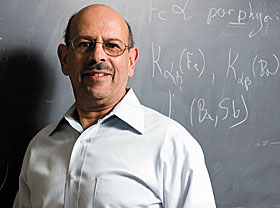  |
| HOME | THIS ISSUE | CALENDAR | GRANTS | BACK ISSUES | < BACK | NEXT > |
Physics professor invents tool for use in crime scene investigationsby Michael Kirk - April 2, 2007 | ||||
| A UConn physics professor has helped invent and test a device that could significantly aid law enforcement in locating and identifying evidence at crime scenes.
The device, a portable x-ray fluorescence instrument about the size of a large hand-held camcorder, will enable police officers to quickly and clearly detect and analyze a variety of evidence from suspects and crime scenes, including gun shot residue, blood, semen, and numerous other forms of trace evidence. “The average police forensics lab can sometimes be backed up for a long time,” says Professor Jeffrey Schweitzer, one of a group of researchers who developed the device. “This will allow law enforcement to speed up the process of identifying evidence and allow them to see evidence that cannot otherwise be found. “There are techniques where analyzing evidence actually alters it, whereas this is completely non-destructive,” Schweitzer adds. “Most importantly, analysis at the crime scene allows the information to immediately be used for investigative purposes, to identify possible suspects or clear other individuals from investigation.” The device uses fluorescent x-rays to identify specific compounds in the materials that are being looked at, such as iron hemoglobin in blood, zinc in semen, or barium and antimony in gunshot residue. The instrument can be adjusted in its operating properties to provide maximum sensitivity for specific types of evidence. “From the measured spectra, peaks are identified that are attributed to specific elements,” says Schweitzer. “What’s found is processed on a built-in computer, but the display will be a ‘red light or green light’ approach to immediately let an investigating officer know if what is being examined is useful evidence.” In the case of a drive-by shooting, for example, a police officer could analyze the hands of suspects who might have been in the car to determine whether there was residue from firing a weapon. Schweitzer notes that if a gun was fired from a car, every passenger would have some residue on them, but the shooter would have far more. Or if blood stains on a wall had been painted over after a crime had taken place, the device could detect and analyze the presence of the blood through the paint. Schweitzer is careful to note that it is important to differentiate between substances that are part of a crime, and, for instance, barium on a mechanic’s hands left over from working with brakes on a car. “For every type of evidence, you have to have an analytical test to say whether it’s good or not,” said Schweitzer. “For instance, you need to determine if you see iron due to blood or, for example, from paint on a wall that the blood might be on. Of greater importance is the creation of scientifically established data bases, such as those that exist for DNA, to provide reliable statistics on the correctness of any interpretation derived from the measured spectra.” His work was recently presented at the American Academy of Forensic Science meeting in San Antonio, Texas, and was funded by NASA and the National Institute of Justice as a dual-use technology that can be used both for forensics and on planetary missions. Schweitzer collaborated with colleagues from Goddard Space Flight Center, the Massachusetts state forensic laboratory, the New York state forensic investigation center, and Pace University. The prototype device is currently housed at NASA’s Goddard Space Flight Center in Greenbelt, Md. |
| ADVANCE HOME UCONN HOME |

